Proper preparation before Botox is crucial for ensuring a smooth procedure and optimal results. Understanding the steps helps minimize risks and enhances overall safety and effectiveness of treatment. Always consult your provider for personalized guidance to achieve the best aesthetic outcomes. Pre-Botox instructions are designed to address various factors, from lifestyle adjustments to medical considerations, ensuring a safe and successful experience.
1.1 Understanding the Importance of Pre-Botox Preparation
Pre-Botox preparation is essential to ensure a safe and effective treatment outcome. Proper preparation minimizes potential risks, such as bruising or uneven results, and enhances the overall success of the procedure. Factors like medical history, current medications, and lifestyle habits play a significant role in how your body responds to Botox. By following pre-treatment guidelines, you can avoid complications and achieve the desired aesthetic results. Ignoring these steps may lead to suboptimal outcomes, making it crucial to adhere to your provider’s instructions for a smooth and satisfactory experience.
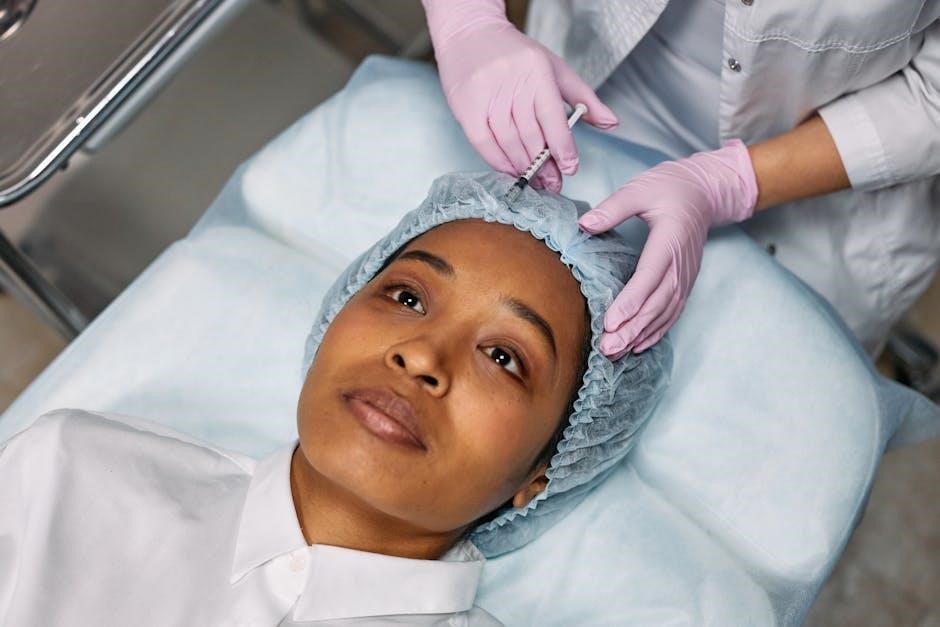
Key Pre-Botox Instructions
Essential steps include avoiding certain medications, refraining from alcohol, and stopping blood thinners to minimize risks. These precautions ensure a safer and more effective treatment outcome.
2.1 Avoiding Certain Medications and Supplements
To ensure a safe and effective Botox treatment, it’s crucial to avoid specific medications and supplements. Blood thinners, NSAIDs, and certain vitamins can increase the risk of bruising or bleeding. Additionally, supplements like fish oil, vitamin E, and St. John’s Wort should be paused to minimize complications. Always inform your provider about your current medications, as some may interact with Botox. Antibiotics and other medications should also be discussed to avoid potential issues. By temporarily discontinuing these substances, you reduce risks and promote a smoother recovery. Proper preparation ensures the best possible outcome for your aesthetic goals.
2.2 Refraining from Alcohol Consumption
Refraining from alcohol consumption is essential before Botox treatment to minimize risks. Alcohol can thin the blood, increasing the likelihood of bruising and swelling at injection sites. It’s recommended to avoid alcohol for at least seven days prior to your procedure to ensure optimal results. Additionally, alcohol can interfere with your body’s ability to heal and may prolong recovery time. By abstaining from alcohol, you reduce the chance of complications and support your skin’s healing process. This simple precaution helps ensure a safer and more effective treatment outcome. Always consult your provider for personalized advice.
2.3 Avoiding Blood Thinners and NSAIDs
Avoiding blood thinners and NSAIDs before Botox is crucial to reduce the risk of bruising and swelling. These medications, such as aspirin, ibuprofen, and warfarin, can thin the blood, making it harder for it to clot. This increases the likelihood of post-treatment bruising. It’s recommended to stop taking these medications at least one week before your appointment. Always consult your healthcare provider before discontinuing any prescribed medications. By avoiding blood thinners and NSAIDs, you minimize the risk of complications and promote smoother, more even results from your Botox treatment. This precaution ensures a safer and more effective procedure.
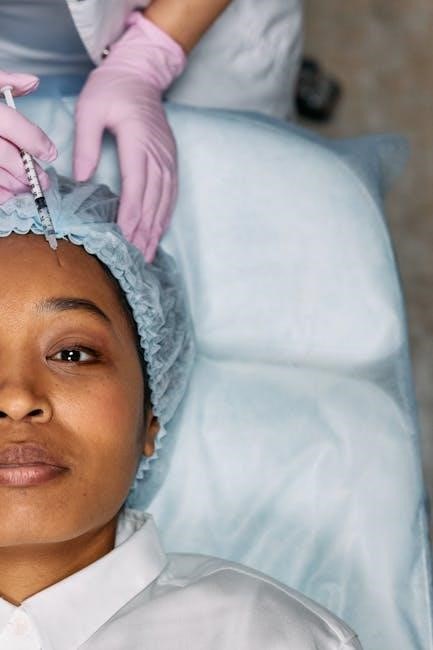
Medical History and Lifestyle Considerations
Disclosing medical history, including allergies and conditions like neuromuscular disorders, is essential. Lifestyle factors, such as smoking or alcohol use, may impact results. Consult your provider for personalized guidance.
3.1 Discussing Medical Conditions and Allergies
Informing your provider about medical conditions, such as neuromuscular disorders or allergies, is critical. Certain allergies, like those to botulinum toxin or human albumin, may contraindicate treatment. Disclose any history of allergic reactions or sensitivity to ensure safety. Additionally, conditions like myasthenia gravis or Lambert-Eaton syndrome require special consideration. Your provider may also inquire about past experiences with similar treatments. Open communication about your health helps tailor the procedure to your needs and minimizes potential risks. Honesty about your medical history is key to a safe and effective Botox experience.
3.2 Informing Your Provider About Current Medications
Disclosing all current medications and supplements is essential before Botox treatment. Blood thinners, NSAIDs, and certain vitamins like vitamin E can increase bruising risks. Inform your provider about antibiotics, as they may interact with Botox. Even supplements like fish oil or St. John’s Wort should be mentioned. Failure to disclose medications can lead to complications, such as prolonged bruising or reduced treatment efficacy. Your provider may advise pausing specific medications temporarily. Honesty about your medication regimen ensures a safer and more effective procedure. This step is critical for avoiding potential drug interactions and optimizing your Botox experience.
3.3 Lifestyle Adjustments Before Treatment
Making lifestyle adjustments before Botox can significantly impact the treatment’s success. Avoid excessive sun exposure, as it may worsen wrinkles and reduce treatment effectiveness. Quit smoking, as it impairs skin health and increases bruising risks. Limit alcohol consumption, as it can thin the blood and prolong healing. Maintain a balanced diet rich in vitamins and minerals to support skin health. Stay hydrated to ensure your skin is in optimal condition. Avoid strenuous exercise for 24 hours before treatment to minimize sweating, which could interfere with the procedure. These adjustments help ensure a safer and more effective Botox experience with minimal side effects.
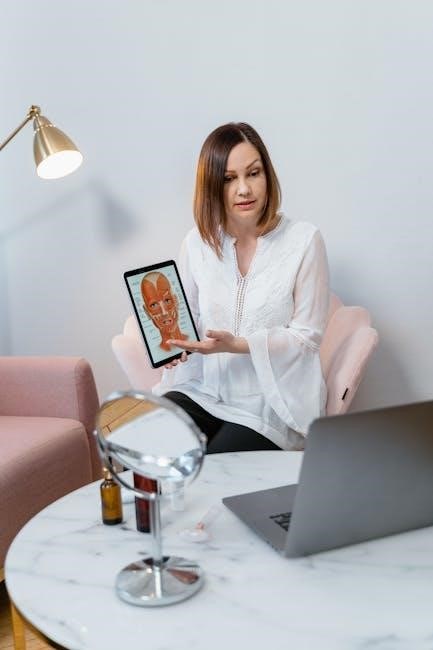
Pre-Treatment Skincare and Hygiene
Cleanse your skin thoroughly before Botox to remove dirt and oils. Avoid makeup and skincare products to prevent interference with the treatment. Proper hygiene ensures effective results and minimizes complications.
4.1 Cleansing and Preparing the Skin
Thoroughly cleanse your face using a gentle, non-exfoliating cleanser to remove dirt, oil, and impurities. Avoid harsh products or exfoliants that could irritate the skin. Gently pat dry with a clean towel, ensuring no residue remains. Arrive at your appointment with a clean, makeup-free face to allow the practitioner to administer Botox accurately. Proper skin preparation helps prevent complications and ensures the toxin is administered effectively. Maintaining a consistent skincare routine beforehand also supports optimal results and minimizes the risk of adverse reactions.
4.2 Avoiding Makeup and Skincare Products
It’s essential to avoid wearing makeup, including foundation, eyeshadow, and mascara, on the day of your Botox treatment. This ensures a clean canvas for precise injections. Additionally, refrain from using retinoids, exfoliants, or acidic skincare products for at least 24-48 hours before treatment to minimize irritation. Avoiding these products helps prevent potential side effects, such as redness or swelling, and allows the Botox to be administered more effectively. Arriving with a bare face and avoiding heavy skincare routines beforehand ensures a safer and more accurate procedure, reducing the risk of complications and promoting the best possible results.

Psychological and Emotional Preparation
Psychological preparation is vital for a stress-free Botox experience. Managing expectations ensures realistic outcomes, while addressing anxiety helps calm nerves. Open communication with your provider can ease concerns and build confidence, making the process smoother and more comfortable.
5.1 Managing Expectations and Understanding Results
Managing expectations is key to a satisfying Botox experience. Understanding that results are not instantaneous and may take a few days to fully appear helps set realistic goals. It’s important to discuss your desires with your provider to ensure alignment and avoid unrealistic expectations. Natural-looking results are often the aim, so conservatism in treatment is crucial. Factors like age, skin condition, and muscle activity influence outcomes. Being aware of these variables ensures a more positive experience. Open communication with your provider can address concerns and tailor the treatment to your unique needs, fostering trust and confidence in the process.
5.2 Addressing Anxiety or Nervousness
Addressing anxiety or nervousness before Botox is essential for a calm experience. Open communication with your provider can help alleviate fears and answer any questions. Understanding the procedure and its benefits can reduce apprehension. Many find comfort in knowing Botox is a minimally invasive treatment with minimal downtime. Deep breathing exercises and relaxation techniques can also help ease nerves. Remember, it’s normal to feel anxious, but being informed and prepared ensures a smoother process. Your provider is there to guide you and make you feel comfortable, ensuring a positive and stress-free experience.
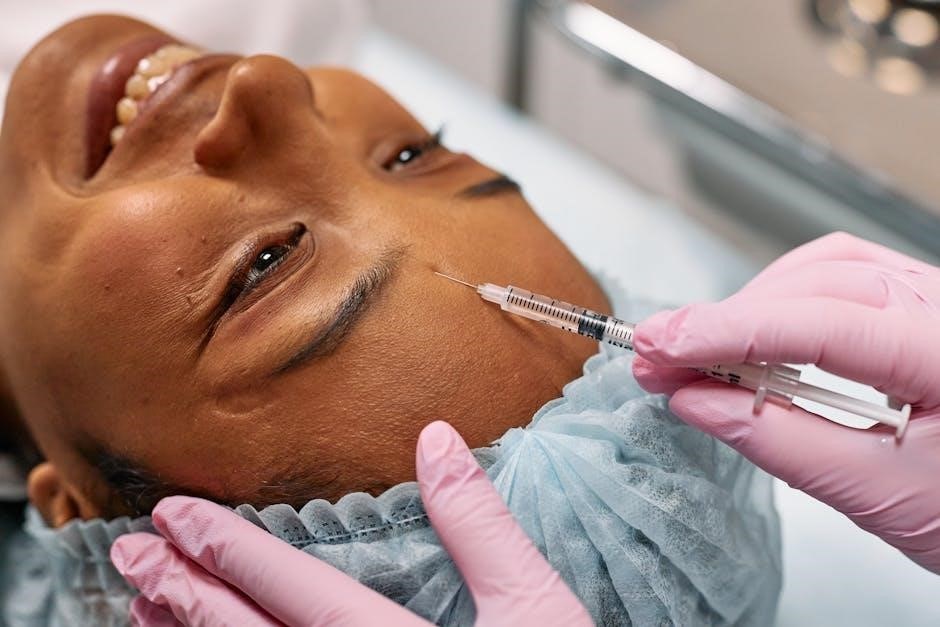
Post-Procedure Care and Follow-Up
After Botox, avoid strenuous activities for 24 hours and keep your head upright. Schedule a follow-up to monitor results and address any concerns or discomfort.
6.1 Immediate Aftercare Instructions
After Botox, avoid strenuous activities for 24 hours to prevent spreading the toxin. Keep your head upright and avoid lying down for at least 4 hours. Refrain from rubbing or massaging the treated areas, as this can affect results. Mild bruising or swelling may occur; apply a cold compress if needed. Avoid heavy exercise, bending, or lifting to minimize discomfort. Do not touch the injection sites excessively, as this could cause irritation. If you experience unusual symptoms, contact your provider immediately. Proper care ensures optimal outcomes and reduces the risk of complications.
6.2 Scheduling a Follow-Up Appointment
Scheduling a follow-up appointment is essential to monitor the effectiveness of your Botox treatment. Typically, this is recommended within 2-3 weeks post-procedure. During this visit, your provider will assess the results and address any concerns. If needed, additional adjustments can be made to achieve the desired outcome. Consistent follow-ups ensure long-term satisfaction and help maintain the aesthetic benefits. Be sure to discuss any questions or issues with your provider during this appointment to ensure a personalized and successful treatment plan. Regular check-ins are key to maintaining optimal results and addressing any potential touch-ups.
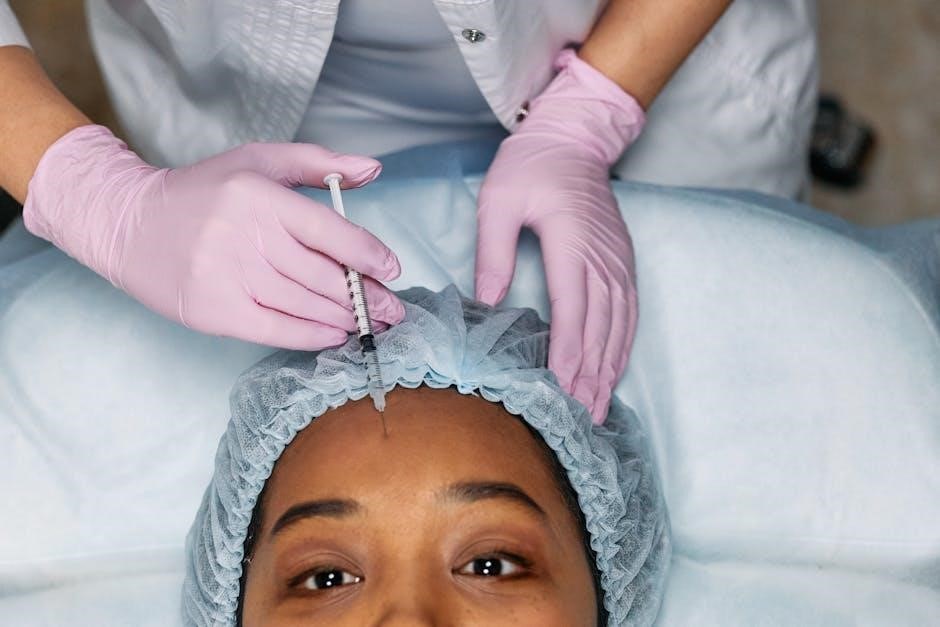
Additional Tips for Optimal Results
Adopting a healthy lifestyle, staying hydrated, and protecting your skin from sun damage can enhance Botox results. Avoid smoking and excessive sun exposure to maintain optimal effectiveness. Regular exercise and balanced nutrition support overall skin health, ensuring a more radiant and youthful appearance. By combining these habits with proper pre- and post-care routines, you can maximize the benefits of your Botox treatment for a natural, lasting outcome.

7.1 Avoiding Strenuous Activities Post-Treatment
Avoiding strenuous activities after Botox is essential to ensure the toxin distributes evenly and effectively. Refrain from heavy lifting, bending, or rigorous exercise for at least 24 hours post-treatment. Lying down or rubbing the treated area should also be avoided for a few hours to prevent migration of the toxin. These precautions help minimize the risk of complications and optimize results. By adhering to this guideline, you can ensure the Botox works as intended, providing a smooth and natural appearance. Following these steps is crucial for achieving the best possible outcome from your treatment.
7.2 Maintaining a Healthy Lifestyle
Maintaining a healthy lifestyle is crucial for enhancing and prolonging the effects of Botox. A balanced diet rich in vitamins and antioxidants supports skin health, while proper hydration keeps your skin hydrated and plump. Avoid smoking and excessive sun exposure, as these can accelerate aging and reduce the efficacy of the treatment. Regular exercise, in moderation, promotes overall well-being and maintains a youthful appearance. Additionally, managing stress and getting adequate sleep contributes to a smoother, more radiant complexion. By combining these habits, you can ensure your Botox results look natural and last longer, complementing your aesthetic goals effectively.

Adhering to pre-Botox instructions ensures a safe and effective treatment. Proper preparation enhances results and minimizes risks, leading to a smoother experience and better aesthetic outcomes. Always follow professional guidelines for the best results.
8.1 Final Reminders for a Smooth Botox Experience
Before your Botox treatment, ensure you’ve followed all pre-procedure guidelines. Avoid blood thinners, alcohol, and certain medications to minimize bruising. Stay hydrated and arrive with clean skin. Don’t forget to discuss any concerns or allergies with your provider. Ask questions to clarify expectations and outcomes. After treatment, avoid strenuous activities and follow aftercare instructions carefully. Remember, results may take a few days to fully appear. Trust your provider’s expertise and stay patient for the best aesthetic results. Proper preparation and adherence to instructions will ensure a safe and satisfying Botox experience.